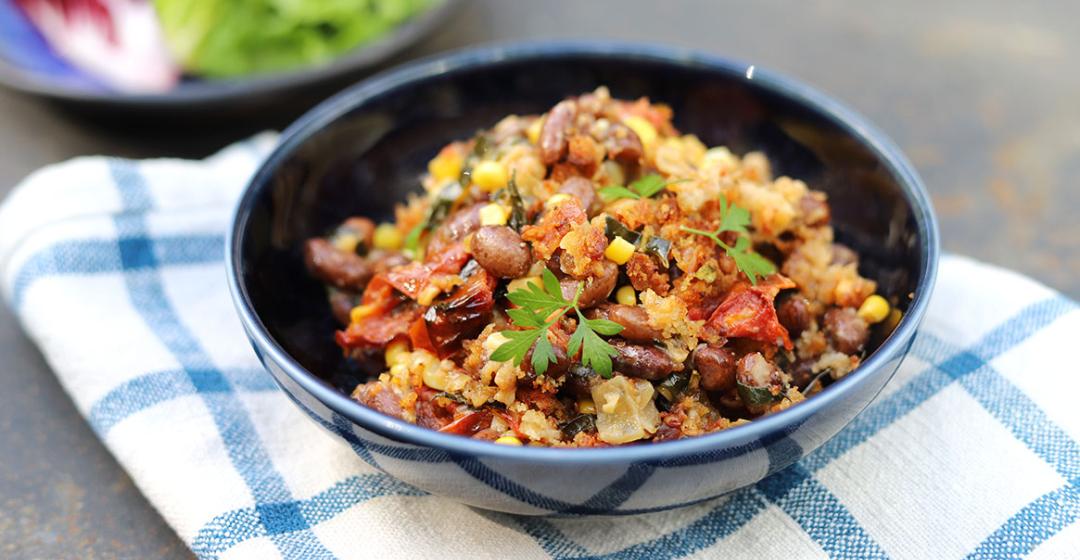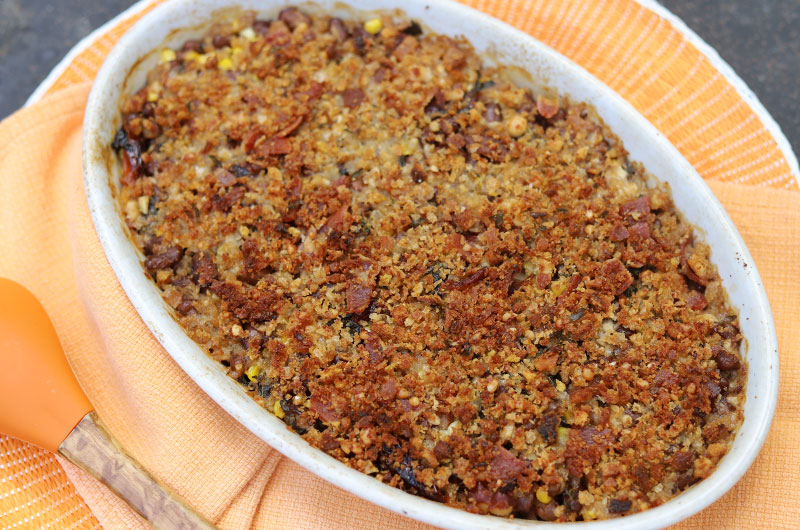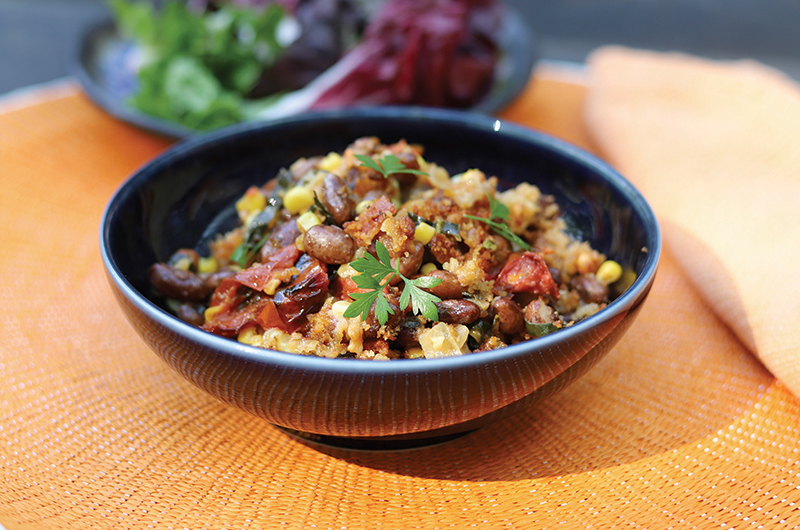This filling gratin is a great destination for late-season veggies. I use roasted plum tomatoes, as well as corn, onions, slivered kale, garlic, and thyme to pair with the earthy flavor of the beans. Which beans? Well, I developed this recipe for the shell beans (Rattlesnake and Cranberry) that I grow in my garden every year. At this point I’ve usually dried them, so I cook them like any other dried bean before using them in the gratin. But you could use pinto beans or white beans too – just cook them yourself rather than using canned for the best texture.
For the liquid in the gratin, you have leeway. I like to use some of the bean-cooking water and cut it (depending on how much I salted it) with either low-sodium broth, water, or, yes, heavy cream (my favorite). Just a touch of cream carries the flavors around. But you can leave out the cream, the bacon, and the Parmigiano to make a vegan or lower fat version.
Serves 4
For the topping:
- 1 cup fresh breadcrumbs
- ¼ cup coarsely grated Parmigiano
- 1 tablespoon olive oil
- 1/2 teaspoon chopped fresh thyme
- Kosher salt
For the gratin:
- 3 cups cooked shell beans (such as Rattlesnake, Cranberry, or Borlotti), about 1 cup cooking liquid reserved (see bean cooking directions at right)
- ½ to 1 cup low-sodium broth of any kind, heavy cream, water, or a combination
- Kosher salt
- 4 slices thick-cut bacon
- 3 tablespoons olive oil
- 1 cup diced yellow onion
- 1 to 1¼ cups corn kernels (cut from about 2 ears)
- 1 cup very thinly sliced Tuscan kale (leaves only, stems removed)
- 2 teaspoons minced fresh garlic
- ¼ cup coarsely grated Parmigiano
- 2 teaspoons chopped fresh thyme
- 1 teaspoon balsamic vinegar
- 12 to 14 roasted plum tomato halves,each cut into 4 pieces (see roasting directions below or follow recipe here)
To make the topping:
In a small bowl, combine the breadcrumbs, Parmigiano, olive oil, thyme, and a pinch of salt. Mix well.
To make the gratin:
1. Heat the oven to 375 degrees. Rub a two-quart gratin dish or shallow casserole (or four individual two-cup casserole dishes) with oil.
2. Combine about 2/3 cup of the reserved bean liquid with the 1/2 cup of broth, heavy cream, or water. Taste the liquid for saltiness. Set aside. (If the bean broth was salted, you won’t need any additional salt. If using water, you may need a small bit.)
3. In a medium skillet, cook the bacon over medium heat until cooked to your liking. Transfer to a paper towel–lined plate. Crumble or chop when cooled.
4. Discard all but 1 tablespoon of the bacon fat from the skillet. Add 2 tablespoons olive oil and the onion to the skillet. Season with a pinch of salt and cook, stirring occasionally, until softened and lightly browned, about 5 to 7 minutes. Add the corn kernels and cook, stirring, until they glisten and lose their opacity, about 2 minutes. Stir in the kale and cook until wilted, 30 seconds to 1 minute. Add the garlic and cook, stirring, until softened and fragrant, about 1 minute. Remove the skillet from the heat.
5. In a large mixing bowl, combine the beans and the contents of the skillet. Stir in the remaining tablespoon of olive oil, roasted tomatoes, 2 teaspoons chopped thyme, balsamic vinegar, and a ½ teaspoon kosher salt. Mix well.
6. Pour the contents of the bowl into the oiled gratin dish (or dishes) and spread evenly. Sprinkle the crumbled bacon over the surface. Add enough of the reserved bean liquid–broth/heavy cream/water mixture that it reaches the top of the beans. Sprinkle the breadcrumb mixture evenly on top.
7. Bake for 30 to 35 minutes or until liquids have bubbled down, leaving a brown line around the edge of the beans, and the breadcrumbs are golden.
To cook dried shell beans:
1. Soak beans overnight in cold water, drain. Put beans in a large pot with a bay leaf, a sprig of thyme, and a clove of garlic. Cover with at least 3 or 4 inches of water, bring to a boil, reduce to a simmer. Cook for 50 minutes and taste a bean for texture. At this point, add a ½ teaspoon of salt to the water. Continue cooking for 10 minutes and taste again. The beans will be done when they have a pleasing texture – they will be softer than al dente but still hold together. If not, continue to cook and taste for a few more minutes.
2. Put a glass measure and a colander in the sink. Before draining the beans, pour or ladle some (a cup or more) cooking liquid into the glass measure. Drain the beans and spread on a sheet pan to cool.
To roast plum tomatoes:
Heat the oven to 400 degrees. Cut plum tomatoes in half lengthwise and scoop out seeds. Arrange on a parchment paper–lined sheet pan, cut side-up. Season the cavities with a pinch of salt, pinch of sugar, a few thyme leaves, and a few drops of balsamic vinegar (if desired). Drizzle a generous amount of oil overall, making sure the bottoms of the tomatoes are oiled too. Roast in the oven, checking after 30 minutes and again every 10 minutes or so, until the tomatoes are well-reduced (they will be flat) and a deeper color with some deep browning around the edges, a total of 45 to 55 minutes.





 2 comments
2 comments



Comments (2)